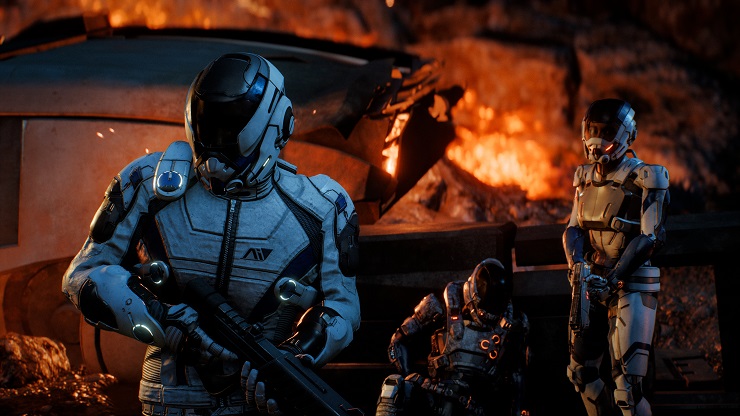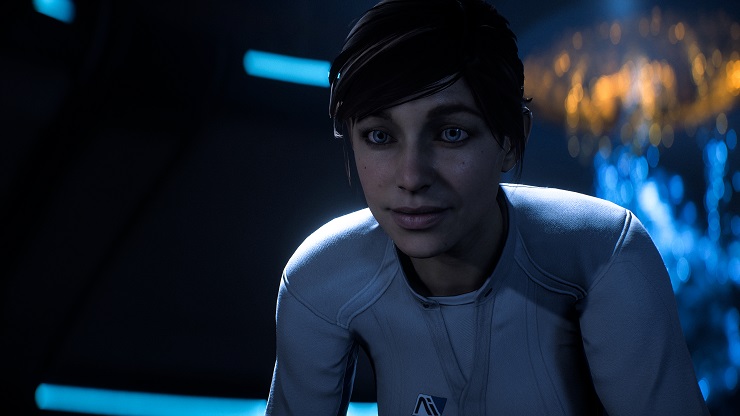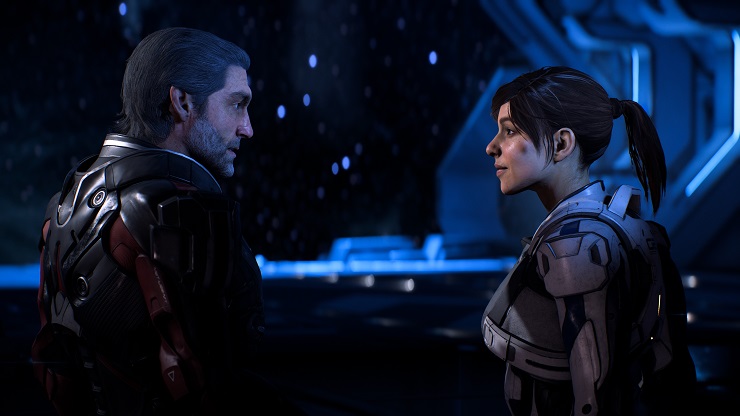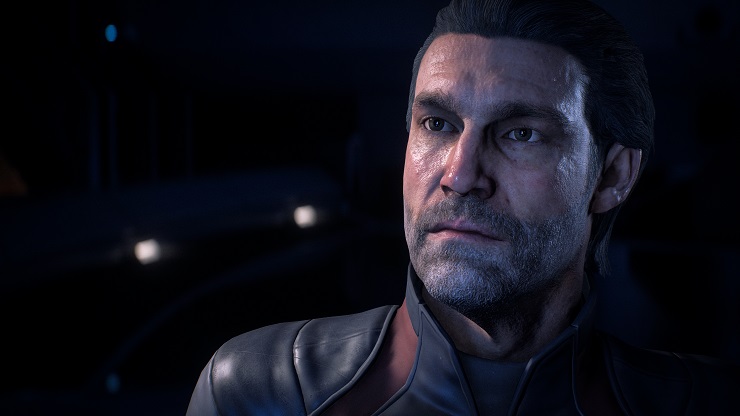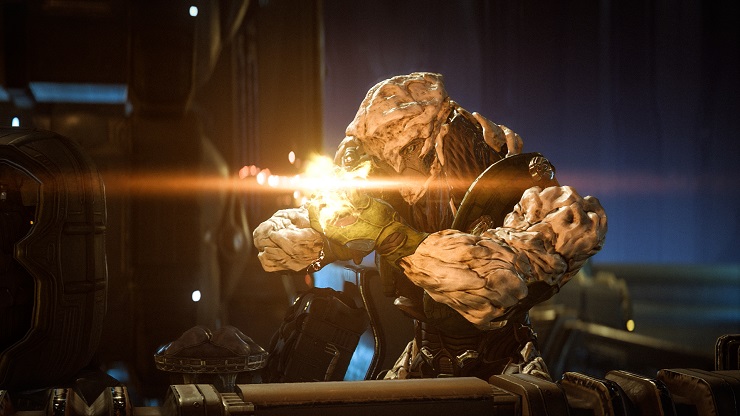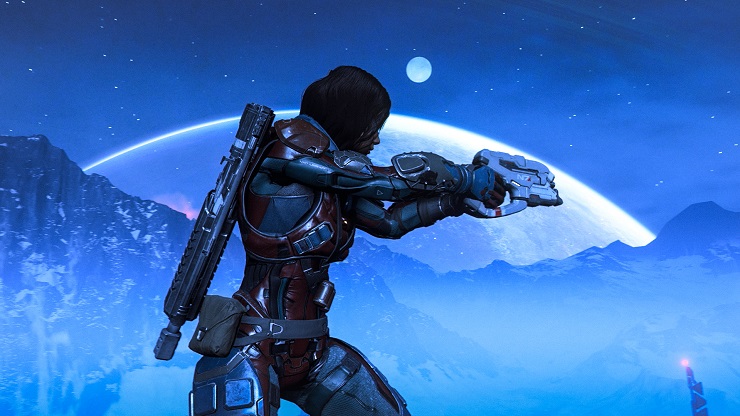Mass Effect is back!
And if it feels like it has been away for ages, that’s because it has been away for ages. Mass Effect: Andromeda has been five years in the making. Five years! That’s ages, as producer Fabrice Condominas keeps telling me. I know, I reply, thinking back five years to a happier time when I had hair, hope, and hadn’t yet spunked money on a Mighty No. 9 kickstarter.
What does five years bring you in gaming? A lot of changes anchored to a lot of familiarity, with Mass Effect: Andromeda walking the tightrope between pushing forward while keeping a firm grip on its past.
Shepard is gone, sacrificed to the 4chan gods after that awful Mass Effect 3 ending, and you now play as the ‘Pathfinder’.
Pathfinder is part of the Andromeda Initiative, leading an ark into the Andromeda galaxy to find a new home for humanity. You’ve left everything behind and now look for your place in a world where powerful aliens have already made their home and other aliens, with their own arks, are looking to make theirs. The ark can’t sustain life indefinitely and your new hosts aren’t quite ready to hand over a slice of the galaxy for free.
There’s friction on the horizon and the clock is ticking…
Golden planets aren’t as rude as you think they are
I played through a scouting mission on Habitat 7, which is a ‘golden planet’. No, not like that. NOT like that, I said. ‘Golden planets’ are ones that have been identified as the strongest candidates for settlement. You’re scouting the planet, which begins as all good scouting missions do – with me pressing all the buttons to see what they do, while Pathfinder’s crew-mates watch on in horror, mildly terrified at the person randomly jumping and dashing around in front of them.
So first of all, yes, you can jump and dash.
Jumping! In Mass Effect! It only took four games for it to happen. Mass Effect has never been the most graceful of series, as you never really had to do more than slam your bulky metal armour behind bulky metal cover, popping out to shoot and whittle down shield and life bars. You can still run, but now you can also dash, jump, and even use your jetpack to hover in mid-air. This allows for some brief platforming sections on Habitat 7, but it’s in the combat scenarios that you realise the benefit this added movement has. More on that later.
You can also scan things! Which is more exciting than it sounds because we don’t mean scanning like you do with those invoices on a Tuesday morning. Tapping down on the d-pad brings up a scanner, which highlights orange items that are prime scanning material. Whether it’s a dead body, a strange-looking planet, or an unusual piece of tech, scanning will bring up an info file on the object of interest. It taps into that mesmerising rhythm of all Mass Effect games, where you touch down in a new area and then slowly pick its bones clean of all missions, secrets, lore, and General Stuff To Do.
Scanning also prompts conversation between yourself and whatever crew you have with you at the time, which is a nice way to bring out their personalities. Scanning can also, as I find out on a later planet, flags up side-quests when I scanned a dead body to trigger a murder mystery of sorts.
Habitat 7 is also an example of the new open-world gameplay that Mass Effect: Andromeda will deliver. It’s not open-world in a Skyrim or Fallout way, where you’ll walk across vast terrain until a distant building hundreds of miles away piques your interest and you walk all the way there only to find a single Stimpak. No, if you’ll forgive the terrible analogy, this is more open world in an ant colony way. Habitant 7 is stuffed with linear paths that break off in different directions. Some loop back on themselves, some lead to interesting new areas, some take you to more paths that branch off. Fabrice was keen to emphasise the exploration aspect of Mass Effect: Andromeda, with BioWare keen to bring back the feeling of exploring new worlds, and Habitat 7 is a shining example of that.
There’s incentive to explore as well. As you push through Habitant 7, optional missions begin to pop up. You’ll see flares fizz into the sky overhead. Where did that come from? Who was responsible? An optional mission will come up to investigate, with a marker indicator where you should travel. Same with a crashed alien ship to investigate, same with a fellow member of your crew you need to rescue.
Jumping and shooting > taking cover
You soon discover you’re not alone on Habitat 7, with a new alien race known as the Kett having already made their way there. You can’t talk to them – they communicate in guttural growls and your first encounter quickly descends into gunfire – they become the first real enemy you face.
Remember when we said the new movement lends itself well to combat? This is where you’ll understand how it changes the combat dynamic. Cover is far more effective in Mass Effect: Andromeda, for two reasons. First of all, there’s more of it. You’ll still have the odd gormless Kett sprinting out in the open – maybe he missed Why You Should Stay Behind Cover day at military school, who knows – but generally, they will stay tucked behind cover. Secondly, aliens don’t do that thing you often get in cover shooters where enemies will hide behind cover except for a tiny bit of their head, then remain strangely ignorant when you shoot at that tiny piece of head until they die. Maybe aliens were just really stupid in previous Mass Effect games, thinking about it. No wonder they always ended up on the losing side.
To combat this tendency for the Kett to stay behind cover, you can jump and hover, allowing you to shoot or use your biotec and tech moves to harass and hurt enemies. Later enemies can also jump, while the terrain is far more uneven and awkward to fight on that Mass Effect ever previously allowed, so you can imagine how vertical the fighting becomes. That doesn’t mean the fighting now takes place in the air – you’re away from cover so completely exposed to alien fire whenever you take to the skies, but it changes your tactics and allows you to improvise freely.
You can also improvise with how you level up your character. BioWare has ditched the class system of old and opened it up, so you can mix and match different attributes. You can take your favourite skills from the Soldier class, for example, and mix it in with traits from the Adept class. You’ll notice a lot of old skills have returned – Pull, Throw, Nova, Frag Grenades – along with intriguing new skills, such as Trip Mines and Flamethrowers.
ONBOARD THE TEMPEST WHICH IS LIKE THE NORMANDY EXCEPT IT’S NOT
Having completed the mission, I was then whisked forward a couple of hours by BioWare’s producer, and onboard the Tempest. This is Andromeda’s answer to the Normandy. The Tempest is smaller than that ship, apparently, although it didn’t feel like it once I started to poke and prod around.
The onboard gameplay is the same as it was in previous games – chatting to crew members, reading emails (one email comes from a freelance video-maker who wants to have a chat with you – is this the new reporter who we can punch in the face?), awkward flirting. Speaking of which, I’m told there will be “more shades of grey” in the romance. But after a couple of flirty lines to Suvi, the Scottish pilot of the Tempest, she was already whispering “I like you back” under her breath rather than more realistic lines like “go away” or “seriously, please, go away, I hate you.” It still seems quite easy. Maybe I just got lucky or maybe my real-life invitations of dates at the local Wetherspoons has distorted my view on these things. Who really knows (don’t answer that).
Poking around the Tempest gave me a chance to meet some of the new crew members – Peebee the Asari (edgy), Drack the Krogan (angry), and Jaal the Angaran (new!). Angaran is a new alien race for Mass Effect: Andromeda, so he was the one I spent the most time with. Jaal the Angaran speaks slowly, solemnly, and seriously. He has cat-like eyes and broad shoulders, and reminds us of Mass Effect 3’s Javik, although Jaal seems to be a more sympathetic character. He’s also bloody huge.
There’s a research and development console at the back of The Tempest. Throughout our time on Habitat 7, I picked up lots of raw material, which hinted at a crafting system being implemented in Mass Effect: Andromeda. Sure enough, that’s exactly what this console is for, with the other expense for crafting items being research points that are earned for scanning items.
No more renegade or paragon options
The next stop is Kadara, Habitat 4. The small hub you land on is reminiscent of Mass Effect 3’s Omega, even down to the nightclub (Kralla’s Song this time rather than Afterlife), although Kadara bathed in sunshine rather than neon lights at night. Kadara is in the midst of a power struggle between a pirate group called Outcasts and spies and smugglers known as the Collectives. You need to step into the middle of this battle to find someone called Vehn Terev, and to do that you need to talk to the angry war-painted Asari.
It’s at this point it’s clear that the conversation system has changed since the previous three games. The Renegade and Paragon options are gone – Fabrice tells me later that BioWare found this option too binary for what it wanted to do – and this has been replaced with conversation options that fall under categories such as Casual, Emotional, Logical, and Professional.
Gone with the Renegade and Paragon mechanic are greyed out conversation options that only open up if you have enough Renegade or Paragon points. BioWare says this new conversation mechanic makes things feel more organic and natural. Perhaps so but honestly, it’s disappointing that Bubbling Fury doesn’t seem to be a conversation option anymore – no conversation option in our time with Andromeda came close to the scorching hot bad-assery of Renegade FemShep.
Driving around in the Nomad
By playing nice with the Asari, I gain access to Vehn Terev, who sends me to the Badlands for the next part of the mission. And the Badlands means I get to play with the Mako! Or rather, the Nomad, as it’s now called.
The Mako was one of those features that wasn’t executed particularly well, but was tied into the heavier exploration aspect the original Mass Effect favoured, so when the Mako was removed from subsequent game, fans clamoured for its return. Honestly, driving around most empty planets in something that handled like an empty crisp packet being blown around in a breeze wasn’t that much fun but I actually got to explore planets.
Andromeda tackles that problem and the Nomad accomplishes what the Mako failed to in a few ways:
1. The Nomad feels like it actually wears more than three socks, which didn’t really sell the illusion much. I know, I know, “but you’re in space, gravity is different” blah blah blah. Thanks Newton. I get it. I’m talking about fun. The Nomad feels like a chunkier, heavier bit of machinery that makes driving around the rocky terrain more fun. Although you can still use your booster jets for jumps, so it’s almost the best of both worlds.
2. That makes running things over more fun. Dark, I know, but it is what it is.
3. You’ll see battles between your enemies and the planet’s creatures. There are huge dinosaur creatures roaming the Badlands and you can draw them towards Outcast or Collective areas to get them to fight. You can pick a side, you can wipe them all out, you can drive away knowing you’ve condemned a camp of men to their death. Up to you!
4. The terrain is actually interesting, compared to Mass Effect 1’s planet-with-two-hills geometry that suggested God used all his imagination when creating Earth and then quickly cobbled together the remaining planets in space before getting back to Overwatch or whatever it is God does. Now planets have valleys, mountains, lakes, hills, daring jumps, even toxic pools that need to be avoided.
5. There are missions you’ll discover while driving around and exploring. You’ll discover Geth (remember them?) architecture and you can explore further to find out what lies behind the mystery of the strange artefacts. You also stumble upon a third party who is setting up the Outcast and Collective to fight. Who are they? What do they want? By following the clues, you can find out.
You get the point. Actual thought has gone into the Nomad and how it is implemented.
Fingers crossed, what this means is I can waste away hours scanning planets, hoping to stumble on odd missions and side-quests, where we get to drive around new planets in the Nomad and feel like an actual space explorer again.
Or feel like, dare I say it, a Pathfinder.
One extra thing because I’m well good at games
Because I’m the Best In The World At Gaming and finished this mission before every other journo in the room, and because I mistakenly bought a 15.40 train ticket back to London Waterloo than an open return, we had time to revisit Kadara. And boy, was I glad I did.
Rather than playing nice with Angry War-Painted Asari Whose Name I Really Wish I Had Written Down Instead Of Writing Notes Like ‘Nightclub Looks A Bit Rubbish’, I decided to be hostile with her. The situation quickly escalated when her guards drew her weapons (you can tap RT to respond in kind) and she decides she won’t give you access to her prisoner. You’re sent on your way and it’s seemingly a dead-end.
This is when you meet with a smuggler who gives you a location to break into the prison. There’s a secret access route around the back. This takes us into Vehn Terev’s prison, undetected, where I have the conversation with him. The outcome is the same – you’re given a location in Badlands, which leads to a lengthy Mako section – but it’s strangely comforting to see how the route to that point played out completely differently.
Fabrice made all the right noises about Mass Effect: Andromeda before I played it. It’ll take the series back to its RPG roots, he said. It’ll make you feel like an explorer, he said. Piffle, I replied, but under my breath and so quietly no-one could hear it. It’s the song and dance I’ve heard from a million and one producers before they launch into their canned lines about listening to feedback from the community and building games from the ground up.
But good lord, Mass Effect: Andromeda might just do it. The open-ended nature of the gameplay is enticing, the new verticality of the combat is thrilling, the exploration in the Nomad is engaging…everything comes together in a way that reminds me how Mass Effect rose to become one of the best series in gaming.
Mass Effect is back and if my time with Andromeda is anything to go by, that five-year absence will definitely be worth it.


